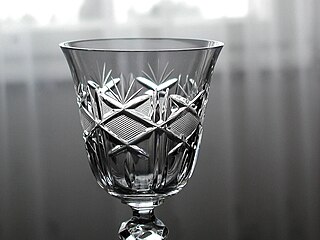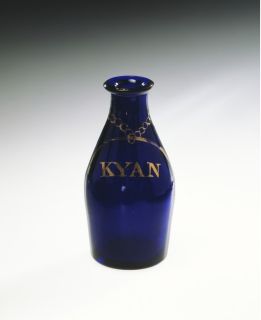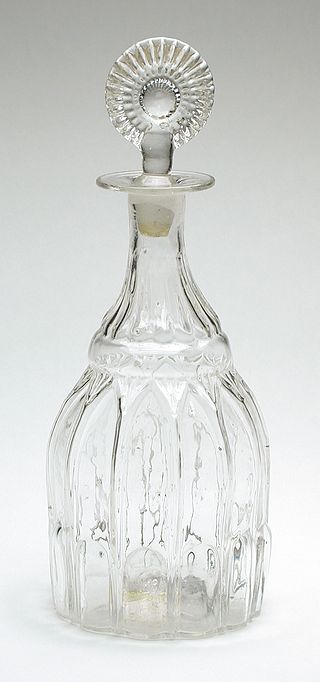
Laboratory glassware refers to a variety of equipment used in scientific work, and traditionally made of glass. Glass can be blown, bent, cut, molded, and formed into many sizes and shapes, and is therefore common in chemistry, biology, and analytical laboratories. Many laboratories have training programs to demonstrate how glassware is used and to alert first–time users to the safety hazards involved with using glassware.

Kufstein is a town in the Austrian state of Tyrol, the administrative seat of Kufstein District. With a population of about 19,600 it is the second largest Tyrolean town after the state capital Innsbruck. The greatest landmark is Kufstein Fortress, first mentioned in the 13th century. The town was the place of origin of the Austrian noble family Kuefstein.

Lead glass, commonly called crystal, is a variety of glass in which lead replaces the calcium content of a typical potash glass. Lead glass contains typically 18–40% lead(II) oxide (PbO), while modern lead crystal, historically also known as flint glass due to the original silica source, contains a minimum of 24% PbO. Lead glass is often desirable for a variety of uses due to its clarity. In marketing terms it is often called crystal glass.

Uranium glass is glass which has had uranium, usually in oxide diuranate form, added to a glass mix before melting for colouration. The proportion usually varies from trace levels to about 2% uranium by weight, although some 20th-century pieces were made with up to 25% uranium.

Baccarat is a French luxury brand and manufacturer of fine crystal located in Baccarat, Meurthe-et-Moselle, France. The company owns two museums: the Musée Baccarat in Baccarat, and the Musée Baccarat in Paris on the Place des États-Unis.

Borosilicate glass is a type of glass with silica and boron trioxide as the main glass-forming constituents. Borosilicate glasses are known for having very low coefficients of thermal expansion, making them more resistant to thermal shock than any other common glass. Such glass is subjected to less thermal stress and can withstand temperature differentials without fracturing of about 165 °C (300 °F). It is commonly used for the construction of reagent bottles and flasks as well as lighting, electronics, and cookware.

A cruet, also called a caster, is a small flat-bottomed vessel with a narrow neck. Cruets often have an integral lip or spout, and may also have a handle. Unlike a small carafe, a cruet has a stopper or lid. Cruets are normally made from glass, ceramic, or stainless steel.
Wine accessories are things that may be used in the storage or serving of wine. Wine accessories include many items such as wine glasses, corkscrews, and wine racks.

A decanter is a vessel that is used to hold the decantation of a liquid which may contain sediment. Decanters, which have a varied shape and design, have been traditionally made from glass or crystal. Their volume is usually equivalent to one standard bottle of wine.

Riedel Crystal is a glassware manufacturer based in Kufstein, Austria, best known for its glassware designed to enhance different types of wines. According to Petr Novy, Chief curator Museum of Glass and Jewellery in Jablonec nad Nisou Czech Republic, Riedel is the oldest family owned and operated global crystal glass brand worldwide. Established in Bohemia in 1756, the company is managed by Georg Riedel and Maximilian Riedel.

A wine glass is a type of glass that is used to drink and taste wine. Most wine glasses are stemware (goblets), i.e., they are composed of three parts: the bowl, stem, and foot.

Beer glassware comprise vessels made of glass, designed or commonly used for serving and drinking beer. Styles of glassware vary in accord with national or regional traditions; legal or customary requirements regarding serving measures and fill lines; such practicalities as breakage avoidance in washing, stacking or storage; commercial promotion by breweries; artistic or cultural expression in folk art or as novelty items or usage in drinking games; or to complement, to enhance, or to otherwise affect a particular type of beer's temperature, appearance and aroma, as in the case of its head. Drinking vessels intended for beer are made from a variety of materials other than glass, including pottery, pewter, and wood.
The Hauptman-Woodward Medical Research Institute (HWI) is an independent, not-for-profit, biomedical research facility located in the Buffalo Niagara Medical Campus. Its focus is on structural biology with a strong history in methods development and the application of X-ray crystallography in fundamental studies.

A champagne glass is stemware designed for champagne and other sparkling wines. The two most common forms are the flute and coupe, both stemmed; holding the glass by the stem prevents warming the drink. Champagne can also be drunk from a normal wine glass, which allows better appreciation of the flavor, at the expense of accentuating the bubbles less.

The Glencairn whisky glass is a style of glass developed by Glencairn Crystal Ltd, Scotland for drinking whisky. Originally designed by Raymond Davidson, managing director of the company, the shape of the glass is derived from the traditional nosing copitas used in whisky labs around Scotland. The glass design was concluded with the aid of master blenders from five of the largest whisky companies in Scotland. The glass first came into production in 2001. Since that time additional mini-Glencairns and Canadian Glencairns were introduced.

Maximilian Josef Riedel is an Austrian glassmaker and businessman. Born in Vienna, he is the 11th-generation CEO and President of Riedel, a glassware manufacturer established in 1756 and best known for its production of grape variety-specific glassware. Riedel is best known for designing the world's first variety-specific stemless wine glasses in 2004, expanding the company to international markets, and developing double-decanting technology.

A faceted glass or granyonyi stakan is a type of drinkware made from especially hard and thick glass and having a faceted form. It is a very widespread form of drinking glass in Russia and the former Soviet Union.
Evidence for early glassmaking in the United States has been found of glassmaking at the English settlement on Jamestown Island, Virginia. While some glass window panes were made there after 1608, most of the windows had been shipped from England.
Claus Josef Riedel was an Czech glassmaker, businessman, professor of chemistry, and chemical engineer. He was the 9th-generation owner of Riedel Crystal, an Austrian glassware manufacturer that was established in 1756. Riedel is best known for creating and producing grape variety-specific glassware designed to enhance types of wines based on specific properties of individual grape varieties. He was among the first glassware experts in history to recognize that the taste of wine is affected by the shape of the glass from which it is consumed, and is credited with first discovering the concept of variety-specificity in glassware, developing variety-specific glassware shapes and bringing these glasses to the consumer market. Riedel served as President and Chief Executive Officer of Riedel Crystal from 1957 until 1994.

Cut glass or cut-glass is a technique and a style of decorating glass. For some time the style has often been produced by other techniques such as the use of moulding, but the original technique of cutting glass on an abrasive wheel is still used in luxury products. On glassware vessels, the style typically consists of furrowed faces at angles to each other in complicated patterns, while for lighting fixtures, the style consists of flat or curved facets on small hanging pieces, often all over. Historically, cut glass was shaped using "coldwork" techniques of grinding or drilling, applied as a secondary stage to a piece of glass made by conventional processes such as glassblowing. Today, the glass is often mostly or entirely shaped in the initial process by using a mould, or imitated in clear plastic. Traditional hand-cutting continues, but gives a much more expensive product. Lead glass has long been misleadingly called "crystal" by the industry, evoking the glamour and expense of rock crystal, or carved transparent quartz, and most manufacturers now describe their product as cut crystal glass.














